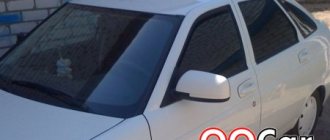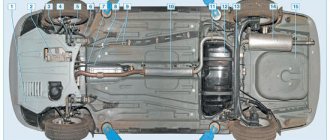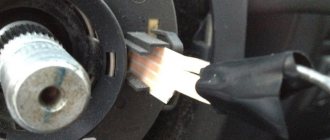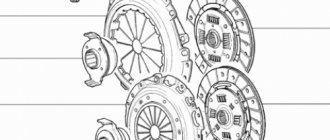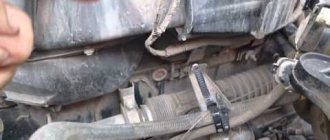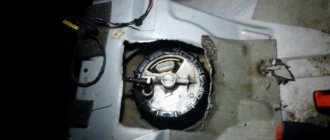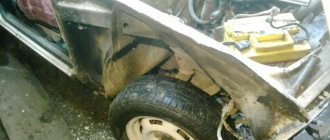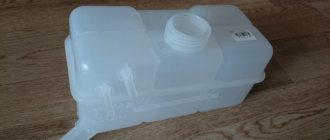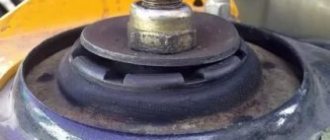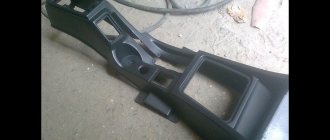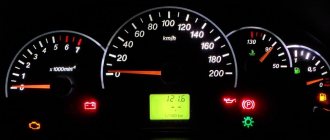Rear shock absorber and spring assembly
Shock absorbers for cars, which are located in the rear of the body, are designed to soften mechanical shocks or even completely absorb their impact on the body of the car. In any case, racks have a certain service life, so the day will come when they will no longer cope well with the task. Replacing rear struts on a Priora is not the worst problem you may encounter while operating your car.
Assembling a new shock absorber
1. Set the rack rod to the upper position.
2. Place the boot and compression buffer on the new front strut.
3. Install the spring, spring cup and damper
Pay attention to the lower shank, it should fall into place
4. Install the small washer from the new Acomi kit, the large washer and the support with the bearing installed.
5. Install the rod mounting nut.
6. The nut is tightened using a hexagon to “6”, hold the rod with it. It is better to do the final tightening after installing the front struts in place.
7. Remove the spring clamps.
8. Turn the support so that the indicator on it looks forward and slightly inside the car body.
9. After this, install the rack assembly in its place of further service.
10. Tighten the support bolts from above, then put the stand on the steering knuckle, install the eccentric bolt with a washer in the upper hole, and a simple bolt down and tighten.
11. Install the steering tip pin into the rod on the rack and tighten the nut.
12. After this, pin the finger, spreading the antennae.
13. Thread the brake hoses into the holder bracket on the rack.
Done, now we can say that the front strut has been replaced. Install the wheel and lower the jack. When the car is on wheels, go through all the fastenings and tighten them. It would be a good idea to rock the body on the side where the strut was changed for additional pumping.
Now all that remains is to repeat the same thing on the left side. The second time things will be “more fun”, since you will already know what is what and why...
After replacing the front struts, be sure to do a wheel alignment; don’t rush on the way to the service station - the wheels are not adjusted and the car will “drive” a little on the road, so be vigilant and careful.
The result of the work done:
After several weeks of using the new racks, I can note the following:
- The knocking has disappeared;
- The suspension has become more elastic;
- The laxity and swaying have disappeared;
- The car began to take turns better, the roll decreased;
- It has become more comfortable to drive off-road;
- The steering wheel began to return noticeably faster after a turn - the result of increased castor;
- Improved handling at high speeds;
- Speed bumps are less painful to overcome.
In short, I am very pleased, the impressions are only positive, if I had known that such a result would be achieved, I would have changed the front struts even before they failed, immediately after the purchase.
Racks, what are they and why are they needed?
VAZ-2110 do-it-yourself replacement of front struts
The struts have a complex design, but the basis is a hollow piston system. The piston system is equipped with multiple parts that secure the racks to the car body, and inside it is filled with either gas-oil liquid or oil. The principle of operation of the struts is that the piston, when it starts to move, seems to break the impacts falling on it, reducing their force.
On the Priora, as on other cars, problems with struts are expressed in oil leakage, insufficient adhesion of the tires to the road surface, and deterioration in maneuverability. Another sign of problems with the rear strut is a sudden, sharp increase in braking distance. According to professionals, if it is necessary to replace one rear strut, then it is wiser to change both at once, since otherwise there may be a mismatch of parts, which will lead to a significant deterioration in the operation of the entire system and a decrease in the dynamics, maneuverability and controllability of the car.
Also check out
- How to replace the cabin filter of a Lada Priora with your own hands
- Algorithm for replacing the front brake pads of Lada Kalina at home
- Installation of silent locks from VAZ 2114 to VAZ 2106 on your own
- The front strut needs to be pulled out of the wheel well.
Replacing the front struts of a Lada Priora with your own hands
Replacing the front struts of a Lada Priora with your own hands
What shock absorbers are suitable for Priora
Replacing rear brake pads on a Ford Focus 2 with your own hands
Replacing rear shock absorbers directly depends on the conditions in which the Lada Priora is used. When the device becomes unusable, both the driver and passengers feel it. Therefore, you will think about a possible malfunction of the racks even before you arrive at the service center and undergo special diagnostics. You can feel the deterioration of the shock absorbers on the road. Your Priora will become less stable when maneuvering while driving at high speed.
Here are the rear struts on the car
In each case, replacing shock absorbers is an individual process. Factory parts, also called oil parts, are more affordable than their gas brothers. But they have one feature associated with a small temperature range. In winter, oil-filled shock absorbers become stiff. Therefore, such parts are offered by specialists only for urban vehicles.
Gas-oil shock absorbers will cost much more, but this price will fully correspond to their manufacturability. You will feel their role in the cold. Simply put, you will not feel any changes when the car moves, but this will be a confirmation of the quality of the rack. It is generally accepted that imported spare parts are reliable and made of high-quality materials, which is why Priora is equipped with Kayaba and SS20 shock absorbers.
Replacing old struts with new ones of improved quality does not guarantee perfect suspension performance. After all, this unit consists of many elements, and only a general replacement of parts can restore comfort and convenience in the process of driving the Priora. In principle, there is nothing complicated about how to replace rear shock absorbers on a front-wheel drive car. Therefore, this information will be useful not only to Priora owners. Drivers of other VAZ models can also use the instructions below.
Rear strut replacement process
Assembling a new shock absorber
Replacing front struts on Kalina
1. Set the rack rod to the upper position.
2. Place the boot and compression buffer on the new front strut.
3. Install the spring, spring cup and damper
Pay attention to the lower shank, it should fall into place
4. Install the small washer from the new Acomi kit, the large washer and the support with the bearing installed.
5. Install the rod mounting nut.
6. The nut is tightened using a hexagon to “6”, hold the rod with it. It is better to do the final tightening after installing the front struts in place.
7. Remove the spring clamps.
8. Turn the support so that the indicator on it looks forward and slightly inside the car body.
9. After this, install the rack assembly in its place of further service.
10. Tighten the support bolts from above, then put the stand on the steering knuckle, install the eccentric bolt with a washer in the upper hole, and a simple bolt down and tighten.
11. Install the steering tip pin into the rod on the rack and tighten the nut.
12. After this, pin the finger, spreading the antennae.
13. Thread the brake hoses into the holder bracket on the rack.
Done, now we can say that the front strut has been replaced. Install the wheel and lower the jack. When the car is on wheels, go through all the fastenings and tighten them. It would be a good idea to rock the body on the side where the strut was changed for additional pumping.
Now all that remains is to repeat the same thing on the left side. The second time things will be “more fun”, since you will already know what is what and why...
After replacing the front struts, be sure to do a wheel alignment; don’t rush on the way to the service station - the wheels are not adjusted and the car will “drive” a little on the road, so be vigilant and careful.
The result of the work done:
After several weeks of using the new racks, I can note the following:
- The knocking has disappeared;
- The suspension has become more elastic;
- The laxity and swaying have disappeared;
- The car began to take turns better, the roll decreased;
- It has become more comfortable to drive off-road;
- The steering wheel began to return noticeably faster after a turn - the result of increased castor;
- Improved handling at high speeds;
- Speed bumps are less painful to overcome.
In short, I am very pleased, the impressions are only positive, if I had known that such a result would be achieved, I would have changed the front struts even before they failed, immediately after the purchase.
practical guide
It is convenient to carry out the work in an inspection ditch. The work is shown on a car with a hatchback body. On a station wagon, the work is performed in the same way. On a sedan car, access to the upper shock absorber mount is through the luggage compartment.
Replace shock absorbers and springs in pairs.
To complete the work you will need:
— inspection ditch or overpass;
— a device for disassembling suspension struts.
We carry out the work with an assistant.
Removal
1. Prepare the car for work and hang the rear of the car on stands.
If there is no inspection ditch or overpass, remove the rear wheel of the car from the side of the shock absorber being replaced.
2. Remove the luggage compartment shelf.
3. Fold down the back seat.
4. In the luggage compartment, use a Phillips screwdriver to remove the four screws securing the upholstery.
5. Use a screwdriver to pry off the trim of the seat back lock.
6. Using a 19 mm wrench, unscrew the lock and remove it.
7. Using a Phillips screwdriver, unscrew the screw securing the luggage compartment lining.
8. Bend down the luggage compartment upholstery.
9. Use a Phillips screwdriver to unscrew the top screw securing the cladding.
10. Using a Phillips screwdriver, unscrew the two lower screws securing the cladding.
11. Move down the luggage compartment lining.
12. Using a 13 mm socket wrench, unscrew the two nuts securing the seat back clamp bracket.
13. Remove the retainer bracket.
14. Using a slotted screwdriver, remove the plug.
15. While holding the shock absorber rod from turning with a 6 mm wrench, unscrew its nut with a 17 mm wrench.
16. Use a magnet to remove the spring washer and the upper support washer from the shock absorber rod.
17. Remove the upper rod mounting pad from the shock absorber rod.
18. Using two 19 mm wrenches, unscrew the nut of the bolt securing the lower end of the shock absorber to the rear axle beam and remove the bolt.
19. Move the lower end of the shock absorber towards the rear of the car and remove the shock absorber.
20. Remove the spring and its gasket from the shock absorber, and also, if necessary, remove the lower cushion and spacer from the shock absorber rod.
Installation
Springs of the same class (with the same color marks) should be installed in the rear suspension of the car.
1. Before installing the shock absorber, secure the rubber gasket 4 to the spring 2 with insulating tape or tape.
2. Install the spring on the shock absorber and fully extend the rod. We put a buffer 1, a protective casing 3 with a cover, a spacer sleeve 5 and a lower cushion 6 (if they are not on the rod) onto the shock absorber rod.
When installing, the shock absorber must be oriented so that the end of the lower coil of the spring faces the wheel.
3. We insert the shock absorber rod into the hole in the body cup, at the same time an assistant puts the upper cushion and support washer on the rod and tightens the rod nut a few turns.
4. Raise the lever until the holes in the shock absorber and beam bracket align. Install the lower shock absorber mounting bolt and tighten its nut (without tightening).
If you don't have an assistant, you can first attach the shock absorber to the rear suspension beam. Then, placing a stop under the rear lever, smoothly lower the car on the jack, making sure that the shock absorber rod enters the hole in the body, and after that, put on the upper cushion with the support washer and tighten the nut.
5. Install the removed wheel (if the work was carried out without an inspection ditch) and lower the car onto the wheels. We press the rear of the car several times to self-install the suspension elements.
6. Tighten the shock absorber rod mounting nut to a torque of 50-61.7 Nm (5.1-6.3 kgcm).
7. Tighten the nut of the shock absorber lower mounting bolt to a torque of 66.6–82.3 Nm (6.8–8.4 kgcm).
DS4 4556555
Pressing the lamp, turn it all the way counterclockwise and remove the lamp from the socket.
Pressing the lamp, turn it all the way counterclockwise and remove the lamp from the socket. Pressing the lamp, turn it all the way counterclockwise and remove the lamp from the socket.
We install the new PY21W lamp in the reverse order. In this case, two protrusions, located asymmetrically relative to the axis of the lamp, must fit into the corresponding grooves of the socket.
We carry out the operations for replacing the remaining lamps in the same way. In addition to the black “ground” wire, each lamp socket is connected to other wires of different colors. In order not to confuse the lamp sockets when installing them, the corresponding wire colors are indicated on the lamp body.
Replacing Priora struts
- The first step is to remove all the existing nuts that secure the racks to the car. Usually craftsmen use a 22*13 key for this task; it is most suitable in this case.
- Now you should secure the car well in order to work safely.
- The next step is to remove the wheel bolts.
- Raise the car with a jack; without this it will be difficult to carry out such exquisite, painstaking work.
- Never forget about safety rules. In this case, it is necessary to remember that it is necessary to place additional support under the wheels of the car in order to exclude the possibility of it rolling away. The emphasis should be in the opposite direction to the lift.
Once the bolt is removed, you can easily pull out the stand itself. The most important thing here now is to understand the cause of the breakdown and be able to fix it. It is necessary to carefully inspect the strut and spring, looking for deformations. Deformed parts must be replaced. Most often, bushings and anthers become faulty, while the bump stop, on the contrary, lasts longer than other parts, since it has a stronger design. Also, sometimes the corrugation casing becomes unusable, but it is easily replaced.
Replacing the rear shock absorber: procedure
Let's take a closer look at the stages of the work. Your first task will be to unscrew the nut that secures the struts to the body. To simplify this matter, it is better to use a special wrench with dimensions 22*13. It is this tool that is used to remove and install shock absorbers in Priora.
After this, you need to securely secure the car, remove the wheel bolts and jack up the car. Never forget to install a safety system in the form of additional support under the wheels of the car. It is important that the stop is installed in the opposite direction to the lift.
So, the preparatory process has been completed, this guarantees fast and safe work on replacing each rear strut. Now you have to remove the rear wheel, remove the lower strut mounting bolt and pull it out. Most likely, this process will involve working with a hammer. After this, the faulty strut must be removed from the car along with the spring. The main thing is to correctly identify all faulty rack elements and replace them with new ones.
Very often the anthers and bushings become unusable. And, for example, a bump stop can last a long time, so you need to pay attention to its condition. Replacing the bellows casing is very simple. It is necessary to install the correct size fender washer on top of this element and place a new or old fender in the corrugation. The boot should be put on the rod, on top of which you need to place a donut-shaped rubber element with an iron bushing.
There is a rubber cushion on the shock absorber spring, which also needs to be removed from the body and checked for suitability. The spring should be correctly oriented and installed on the shock absorber, after which the new struts are ready for installation on the Priora.
The shock absorber is installed with its upper part into the body, and you need to ensure that the rod fits into the hole provided for it. Then the lower part starts. Everything is fixed with bolts and nuts. The lower connection of the rack must be firmly pressed against the beam itself, using keys.
Actions on the upper mount are carried out after the car body has been lowered slightly. This is necessary so that the spring is compressed under the pressure of the total weight of the machine. Assemble a pyramid from a donut-shaped rubber element and a washer and screw the nut onto the rod. Moreover, the rod must be kept motionless, holding it with a key. Tighten the mounting nut securely. After the upper part of the rack support has been assembled and installed, you can install the wheel in its rightful place and lower the Priora from the jack.
The rear struts on the Priora, meaning high-quality factory ones, can last more than 200,000 km under normal operating conditions. Of course, not every car can boast of such mileage before replacing rear shock absorbers. If the racks no longer hold, and the back of your Priora begins to float, or its body is covered in oil (leaked), then they need to be replaced with new ones.
Disassembly of the structure
1. Take the spring tie prepared earlier and install it on the second coil of the spring from above and below as shown in the photo. The second screed is installed on the other side symmetrically to the first. The process of bringing the spring together is carried out as follows - tighten the bolts of the first tie until you feel that the second one begins to move freely on the coils, then tighten it until you remove the load from the previous one. That is, in turn on each side.
2. Take the “22” socket and hexagon and unscrew the fastening nut that secures the strut rod to the support.
3. Remove the limiter (bump stop), support bearing, support, and compression limiter.
4. Replace the old rebound limiter washers with those that came with the Acomi struts
Please note - the bottom one is smaller than the top one
5. Next, remove the spring cup with rubber damper, compression buffer, spring and boot.
Now it is necessary to carry out a visual inspection of the dismantled rack.
The first test of swinging the rod to the top point demonstrated the cause of the malfunction. The resistance in the upper part of the working area quickly disappeared, after which the piston hit the upper part of the cylinder. As you understand, this was the source of the dull knocks.
Basic faults
Failures of a part of the Priora suspension can be judged by the following signs:
- Oil leaks under the wheels. The shock absorber consists of a cylinder, valves, a piston with a rod - all parts actively move, so they need lubrication. If there are leaks, it means the device has become depressurized and will work less efficiently.
- Mechanical damage. If possible, visually inspect the parts - if there is any deformation or rust, it means they have “worked their best.”
- Rock the front (and then the back) of the car in different directions - away from you, to the left, to the right. When you release the car, one or two vibrations are considered normal - it is “damped” by a normal shock absorber. If the car stops immediately, the part is jammed; if it continues to wobble, replace it.
- When traveling, the car begins to wobble, the braking distance increases, and when turning, the car wobbles greatly. Also, when driving over speed bumps, or ordinary potholes, broken shock absorbers do not dampen vibrations at all, that is, the car sways as if on waves, and a knock will be heard.
Service station employees check the suspension with a vibration stand or a special stand. The check goes down to small units - they can even tell you how long it will take to approximately replace them.
Manufacturers and prices of analogues
- A frequently used analogue of Priora struts is the SS-20.
- SS-20 are sporty, they provide greater “strength” of the suspension, and cost accordingly.
- The front part number is SS20118, they cost 6,000 rubles for two pieces. However, there is one “but” - the SS-20 must be installed together with supports that fit the fasteners.
- The price of Priora struts is not that high, because the SS-20 company sells them as a kit. A set of rear shock absorbers costs 5,200 rubles, article number – SS20144. This company has several model lines - standard, sport, comfort, optimal.
- There is an analogue from Trialli: AH-01159 on the left, AH-01360 on the right, the price is 1,900 rubles each. Front shock absorbers at a low price - from Pilenga: SH-P 2771 - O on the left, SH-P 2770 - O on the right. Cost: 1,600 rubles. In terms of replacing rear components, you can take a closer look at Fenox A12288C3 (1,200 rubles) and KraftKT 073542 (1,200 rubles).
- There is an expensive analogue - Kayaba struts for Priora. They are called KYB EXCEL-G (front), the price of the set is 6,000 rubles, the complete rear set will cost about 6,100 rubles.
- An analogue of Demfi is sold under the article number ITM70-2905002, ITM70-2905003, price - 2,100 rubles (front), ITM70-2915004, cost - 1,300 rubles (rear). The model range is quite wide: gas, hydraulic options, and there is an adaptation for a lowering spring. Branded shock absorber mounts for Lada Priora are for sale.
FakeHeader
Comments 9
I don’t even remember what they are from. The store just said stock springs for the Priora. And on the market there were ones with variable pitch pitch, but everything was in the red, and I don’t want an understatement.
I also took springs. I took the Priora catalog and ordered the part from Lada using the number; there were only one of them. 12 turns arrived. with black mark. The label emphasized hardness class B. and who knows what that means.
Symptoms: the front suspension breaks, the front of the car is skewed, knocks, squeaks and rattles when the car hits an uneven surface.
Possible cause: the spring of the front suspension shock absorber strut is damaged or the strut itself is faulty.
Tools: socket set, wrench set, flat-head screwdriver, vice, zip ties, hex wrench.
1. Install wheel chocks under the rear wheels.
Preliminary preparation for replacement
Replacing the shock absorber strut is accompanied by the dismantling of a number of related elements. Troubleshooting them allows you to identify parts with an end of life, so you may need to additionally purchase this or that product.
The service life that the support has is in most cases comparable to replacing the rack. Therefore, experienced car owners recommend purchasing it in advance.
To prevent the need for repeated repairs, it is advisable to replace rubber products. For example, it is recommended to install the boot and bumper new, regardless of the condition of the dismantled elements.
Some car owners perform suspension tuning when replacing the shock absorber strut. One option is to use interturn spacers. This action allows you to increase ground clearance and increase chassis rigidity.
How to benefit from increased ground clearance?
Of course, neither the doubled nor tripled ground clearance of the Priora can compare with the ground clearance of any SUV. However, we should not forget that, in tandem with the improvement of some other characteristics of the car, the Priora’s ground clearance can give good results. Let's clarify now.
The distance from the ground to the bottom is 165 mm. However, knowledge of this fact alone is not enough to draw any conclusions. The motorist must take into account the following characteristics, such as:
Only working to jointly improve all these characteristics can lead to benefit from increasing the Priora's ground clearance.
Replacing Priora struts
- The first step is to remove all the existing nuts that secure the racks to the car. Usually craftsmen use a 22*13 key for this task; it is most suitable in this case.
- Now you should secure the car well in order to work safely.
- The next step is to remove the wheel bolts.
- Raise the car with a jack; without this it will be difficult to carry out such exquisite, painstaking work.
- Never forget about safety rules. In this case, it is necessary to remember that it is necessary to place additional support under the wheels of the car in order to exclude the possibility of it rolling away. The emphasis should be in the opposite direction to the lift.
Once the bolt is removed, you can easily pull out the stand itself. The most important thing here now is to understand the cause of the breakdown and be able to fix it. It is necessary to carefully inspect the strut and spring, looking for deformations. Deformed parts must be replaced. Most often, bushings and anthers become faulty, while the bump stop, on the contrary, lasts longer than other parts, since it has a stronger design. Also, sometimes the corrugation casing becomes unusable, but it is easily replaced.
Sources
- https://www.avtika.ru/qa/819-snjatie-zamena-ustanovka-amortizatornoj-stojki-zadnej-podveski-lada-priora
- https://priora-remont.ru/zamena-zadnix-stoek-i-pruzhin/
- https://1ladapriora.ru/remont/zadnie-stoyki.html
Basic faults
Failures of a part of the Priora suspension can be judged by the following signs:
- Oil leaks under the wheels. The shock absorber consists of a cylinder, valves, a piston with a rod - all parts actively move, so they need lubrication. If there are leaks, it means the device has become depressurized and will work less efficiently.
- Mechanical damage. If possible, visually inspect the parts - if there is any deformation or rust, it means they have “worked their best.”
- Rock the front (and then the back) of the car in different directions - away from you, to the left, to the right. When you release the car, one or two vibrations are considered normal - it is “damped” by a normal shock absorber. If the car stops immediately, the part is jammed; if it continues to wobble, replace it.
- When traveling, the car begins to wobble, the braking distance increases, and when turning, the car wobbles greatly. Also, when driving over speed bumps, or ordinary potholes, broken shock absorbers do not dampen vibrations at all, that is, the car sways as if on waves, and a knock will be heard.
Service station employees check the suspension with a vibration stand or a special stand. The check goes down to small units - they can even tell you how long it will take to approximately replace them.
Types and characteristics of racks
- Oily. Their action is based on the force of hydraulic oil. As a rule, such devices are two-pipe, although sometimes single-pipe ones are also found, but they are less efficient and difficult to operate. Oil racks are easy to install and are wear-resistant and durable. The only disadvantage of this device is that it does not cool well, which ultimately leads to deformation. But with proper care of the car, deformation may not occur soon. But oil parts are cheaper than gas-oil parts.
- Gas-oil ones are in many ways similar to oil ones, but here we have a completely different type of liquid, which means a different operating principle. Here, a part called a gas boost regulates the oxygen pressure, replacing it with nitrogen, which sets the entire system in motion. Such racks are often presented in a single-pipe version, unlike oil single-pipe ones; gas-oil ones are good in everything. The most significant advantage of the system is good heat transfer. The downside is less wear resistance than oil struts, as well as high sensitivity to external factors of various properties.
What are rear struts?
The design and principle of operation of the rear shock absorber struts of the Lada Priora are practically no different from other cars. From the factory, the machine is equipped with SAAZ shock absorbers, which have a two-pipe hydraulic (oil) design.
It provides damping of shock loads due to oil resistance to the piston inside the cylinder. In fact, this design resembles a conventional pump, only oil acts as air.
At the front of the Priora there are also oil struts that work on the same principle. They differ from the rear ones only in the size and design of the body. In addition, the front struts have brackets for attaching tie rod ends.
Oil shock absorbers are quite reliable and durable, and in addition, they provide maximum comfort, as they are considered the softest. However, they also have their drawbacks. The fact is that oil is very susceptible to the influence of temperatures, both high and low. When heated, it becomes too liquid, which causes the shock absorber to “soften” even more.
When exposed to low temperatures, the oil hardens, making the racks as rigid as possible. Naturally, this cannot but affect their condition, and it often happens that after a hot summer or cold winter, shock absorbers begin to “sweat”. This is the first sign of their failure.
Video review of replacing rear struts on a Priora
The report was prepared using the example of a car of the tenth family, but there will be no differences from the Priora. The price of new racks produced by SAAZ, which are factory-made, starts from 1000 rubles per piece. Springs can be bought for 1000 rubles, a set of 2 pieces.
The principle of operation of the rear struts differs little from car to car. The station wagon leaves the machine with a two-pipe hydraulic design that absorbs shock loads due to oil resistance to the cylinder piston. From the outside, these elements look like a pump, only instead of air there is a viscous liquid.
Which ones to choose and their price
Having decided to replace the rear struts, you will have to choose among today's abundance of original spare parts and their analogues on sale. You can, of course, not bother and buy stock oil shock absorbers from the SAAZ plant, exactly the same as those installed on the Priora on the assembly line.
Part numbers:
Their prices vary from 1200 to 1400 rubles (for one rack).
If you want to change the characteristics of the suspension, namely make it softer or stiffer, you can purchase alternative struts. The most popular shock absorbers among Prior owners are SS20.
Replacement
To replace the rear struts yourself, you do not need to go to a service station. This process can be done at home and will not take more than an hour.
Tools and tools you will need:
- jack;
- a “shoe” or an ordinary brick to block one of the wheels;
- wrenches at “6”, at “19”, at “22”;
- rust remover like WD-40;
- small mount.
Work order:
- Place the machine on level ground.
- Secure one of the front wheels with a “shoe” or brick.
- Open the luggage compartment lid, move the trim on one of the rear “glasses” at the place where the pillar is upper mounted.
- Using a wrench set to “22”, unscrew the nut securing the strut, holding the shock absorber rod with a wrench set to “6”.
- Using a jack, lift the car body from the side of the wheel where you plan to replace the strut.
- Having climbed under the car, unscrew the nut securing the lower part of the rack to the rear beam bracket with a “19” wrench.
- If the nut does not budge (soured), treat the threads around it with WD-40, let it penetrate the joint for about 20 minutes, then try again.
- When the nut is unscrewed, remove the bolt and remove the lower part of the shock absorber from the bracket. To simplify this process, you can use a small pry bar.
- Remove the shock absorber.
- Go to the trunk and remove the support washer and strut pad from where the upper part of the shock absorber is mounted.
- Remove the lower spring, cushion, bushing, boot and compression buffer from the shock absorber. If the boot, buffer, or shock absorber pads show signs of damage, they also need to be replaced.
- Carefully inspect the shock absorber spring. There should be no cracks, chips or other signs of destruction on it. If they are present, the spring must be replaced.
- Reassemble the new rack in reverse order.
- Install the new rack by first inserting its rod into the upper mount, and then securing the lower part into the bracket with a bolt.
- It is recommended to finally tighten all connections after the car body has been lowered, i.e. after you remove the jack.
- Upon completion of the work, rock the car body several times on the side where the rack was installed.
- After 100-150 km, tighten the shock absorber mounting nuts.
Replacement procedure
To make a replacement, it is not necessary to send your hatchback to a service station. All this is easy to do yourself at home, the main thing is that you have the tools and your hands grow from the right place.
For such an event you will need:
- “shoe” for blocking the wheel;
- jack;
- keys at 6, 19, 22;
- rust remover;
- mount.
- Lock the front wheel.
- Open the trunk and move the trim on any rear “glass” at the top fixation point.
- Using a 22 wrench, release the rack mount, holding the rod with a 6 wrench.
- Raise the body with a jack on the side where you plan to replace the element.
- Once under the car, use the 19th key to unscrew the fastening of the lower part of the rack. There it is attached to the rear beam. If the process does not go well, then you will need a rust remover - the nut has oxidized. Wait until it gets wet for about 20 minutes and continue working.
- After unscrewing the nut, remove the freed bolt and remove part of the rack from the fixing bracket. This process may require a pry bar.
- Remove the shock absorber completely.
- Go back to the trunk and remove the support washer and strut pad.
- Remove the spring, bushing, boot and quiet block from the strut in sequence. Check the latter for damage. It is better to replace silent blocks at this moment, so as not to repeat the entire event again later.
- Examine the spring for cracks and other signs of deformation. As soon as you find one, rest assured that it’s worth replacing.
- Reassembling the rack occurs in the reverse order.
- It is worth tightening the connections completely only after the body has lowered.
- It is worth tightening the shock absorber mounting nuts 100-200 km after replacement.
It will be useful: Decoding error codes for the Opel Zafira in Russian
As you can see, everything is extremely simple and you don’t need to spend extra money at the service station, just on new parts. Next time you can repeat this procedure faster, but the first time it’s better to slow down and do it right.
Racks, what are they and why are they needed?
Struts are a mechanism whose task is to filter the shocks coming to the car when driving on a bad road. If the racks are of poor quality and not well-designed, then movement becomes a nightmare. This is why driving an expensive foreign car and a budget domestic car, which is sensitive to every bump, are so strikingly different.
The struts have a complex design, but the basis is a hollow piston system. The piston system is equipped with multiple parts that secure the racks to the car body, and inside it is filled with either gas-oil liquid or oil. The principle of operation of the struts is that the piston, when it starts to move, seems to break the impacts falling on it, reducing their force.
Front and rear struts, depending on the manufacturer, can last a different amount of time, for example, standard Saaz rear struts installed on Lada Kalina and Lada Priora can last 75,000 - 85,000 km, after which they require replacement. If you put new ones on a Lada or Priora, of better quality, then they will last 120,000 - 125,000 km, which is already an achievement.
EXTERNAL DIFFERENCES
But here the racks are radically different. Firstly, the rear shock absorbers do not have a special lever for attaching the rotating mechanism, because the rear wheels are always oriented strictly in the direction of travel. And secondly, the lower mount. It is more reminiscent of the classic shock absorber of earlier car models. That is, this is the lower ring with a rubber-metal bushing.
This difference is caused by the way the rear independent suspension is mounted. Both rear pillars of the Priora are attached with the lower part to a special beam, which is fixed to the body with the possibility of vertical movement. On hinges. There are special grooves on the beam where the shock absorber is inserted, secured with a special bolt.
Well, the rod tip has some differences, since the rear supports do not have swivel bearings. In general, it is very problematic to confuse the rear and front struts when purchasing for replacement.
Features of replacing racks
At the beginning of the two thousandth there was a stage of restyling, which took the car along reformist paths. Now the racks have become more reliable, and the power unit is more powerful. But nevertheless, professionals propose to improve the restyled version by replacing the struts, since then its performance will be significantly improved. Although over time, replacement of parts is necessary in any case.
Before you decide to replace parts, you should be 100% sure of this. You can check the working condition of the racks in a very simple, old-fashioned way. You'll have to rock the corner of the car a little. Now count the number of free jumps. If one, then the system is normal. If there is more than one, then urgent replacement of the racks is required, since the old ones can no longer cope with the task assigned to them.
Tips and tricks for motorists
1. Replacing the Priora support bearing without removing the strut is not recommended, in this case the installation of the new product will not occur correctly, which will affect the service life. 2. To prevent dirt and moisture from getting on new products, come up with additional protection for the “supports” under the hood. 3. If you find products in a closed steel case in retail outlets in the price range of 600 rubles - this is a reliable option, feel free to purchase and install. 4. Do not purchase open products where the balls are visible.
How to change the front struts of a Lada Priora - detailed instructions
1. First of all, remove the mounting bolts on the wheel, then install the jack on the side from which you are going to make repairs.
2. Next, unscrew the bolts completely and remove the wheel.
3. It is necessary to disconnect the brake hoses, and then remove them from the holder located on the rack.
4. Take pliers and carefully unscrew the locking cotter pin on the steering end pin, then you need to take it out and unscrew the nut with a “17” key.
5. Now it’s the puller’s turn, install it on the steering end as shown in the photo and press it out of the socket.
6. Unfold the support and start unscrewing the fastening nuts on the steering knuckle. If you followed my recommendations and treated all connections with WD-40, there should be no problems with unscrewing.
7. If necessary, use a hammer to knock out the bolts, being careful not to damage the threads!
8. The top eccentric bolt is used to adjust the camber and has a washer on it that often likes to stick to the strut. Do not throw away the bolt itself; it will be reinstalled during the replacement process. There is no point in remembering the position of the eccentric along the axis, since in any case you will have to go to the wheel alignment.
9. Let's move on. Using a wrench set to “13”, unscrew the fastening nuts that secure the front strut to the body; they are located under the hood.
10. We take out the front strut from the wheel well assembly.
How to independently replace the rear struts of a VAZ 2110
To independently replace the rear struts of a VAZ, it is recommended to follow the following sequence of actions:
- 1. Remove the plastic plug from the rear pillar cups, opening access to the mounting bolt. First remove the rear seat lock, if necessary;
- 2. Unscrew the nut of the rack rod with a special wrench or hold the tip of the rod with a 6 mm open-end wrench while unscrewing the nut;
- 3. Remove the top washer using the magnetic handle. Under the washer there is a rubber gasket, which we also remove;
- 4. At the next stage, it is necessary to lift the rear part of the car on which we are changing the stand with a jack and remove the wheel. Place the removed wheel under the car as a jack safety net;
- 5. Unscrew the lower shock absorber mounting nut: while holding the nut on one side, turn the bolt on the reverse side with a wrench;
- 6. We knock the rack off its seat in the beam, removing it from the car;
- 7. Remove the rubber gasket from the inside of the glass, most likely stuck to it.
Let's disassemble the rack directly:
- 1. Remove the spring;
- 2. Remove the central bushing, lower cushion, upper cup and casing;
- 3. Remove the bump stop from the rack rod.
We perform assembly in reverse order.
